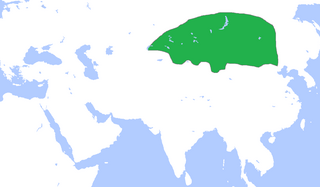
The Göktürks, Türks, Celestial Turks or Blue Turks were a nomadic confederation of Turkic peoples in medieval Inner Asia. The Göktürks, under the leadership of Bumin Qaghan and his sons, succeeded the Rouran Khaganate as the main power in the region and established the First Turkic Khaganate, one of several nomadic dynasties that would shape the future geolocation, culture, and dominant beliefs of Turkic peoples.
The 580s decade ran from January 1, 580, to December 31, 589.
Istämi was the ruler of the western part of the Göktürks, which became the Western Turkic Khaganate and dominated the Sogdians. He was the yabgu (vassal) of his brother Bumin Qaghan in 552 AD. He was posthumously referred to as khagan in Turkic sources. His son was Tardu.
Muqan Qaghan was the second son of Bumin Qaghan and the third khagan of the Göktürks who expanded their khaganate and secured the borders against the Hephthalites.
Chorpan Tarkhan is recorded by Moses of Kalankatuyk as a Khazar general, who conquered Armenia in April 630 CE. He was most likely an officer in the army of the Western Gokturks led by Böri Shad in the wake of Ziebel's victory in the Third Persian-Turkic War. Chorpan Tarkhan ambushed and killed a 10,000-strong Persian cavalry force sent by Shahrbaraz to contain the invasion.

The First Perso-Turkic War was fought during 588–589 between the Sasanian Empire and Hephthalite principalities and its lord the Göktürks. The conflict started with the invasion of the Sasanian Empire by the Turks and ended with a decisive Sasanian victory and the reconquest of lost lands.
The Western Turkic Khaganate or Onoq Khaganate was a Turkic khaganate in Eurasia, formed as a result of the wars in the beginning of the 7th century after the split of the First Turkic Khaganate, into a western and an eastern Khaganate.

The Xueyantuo were an ancient Tiele tribe and khaganate in Northeast Asia who were at one point vassals of the Göktürks, later aligning with the Tang dynasty against the Eastern Göktürks.

The Eastern Turkic Khaganate was a Turkic khaganate formed as a result of the internecine wars in the beginning of the 7th century after the First Turkic Khaganate had splintered into two polities – one in the east and the other in the west. Finally, the Eastern Turkic Khaganate was defeated and absorbed by the Tang dynasty, and Xueyantuo occupied the territory of the former Turkic Khaganate.
Tong Yabghu Qaghan was khagan of the Western Turkic Khaganate from 618 to 628 AD. Tong Yanghu was the brother of Sheguy (r. 611–618), the previous khagan of the western Göktürks, and was a member of the Ashina clan; his reign is generally regarded as the zenith of the Western Göktürk Khaganate.
Böri Shad was a Turkic prince or general who fought the Persians south of the Caucasus during the Third Perso-Turkic War. In this war the Western Turkic Khaganate was allied with Byzantium against Persia during the last great Byzantine-Persian war before the Arab conquests.
The Perso-Turkic war of 627–629 was the third and final conflict between the Sasanian Empire and the Western Turkic Khaganate. Unlike the previous two wars, it was not fought in Central Asia, but in Transcaucasia. Hostilities were initiated in 627 AD by Tong Yabghu Qaghan of the Western Göktürks and Emperor Heraclius of the Byzantine Empire. Opposing them were the Sassanid Persians, allied with the Avars. The war was fought against the background of the last Byzantine-Sassanid War and served as a prelude to the dramatic events that changed the balance of powers in the Middle East for centuries to come.
The First Turkic Khaganate, also referred to as the First Turkic Empire, the Turkic Khaganate or the Göktürk Khaganate, was a Turkic khaganate established by the Ashina clan of the Göktürks in medieval Inner Asia under the leadership of Bumin Qaghan and his brother Istämi. The First Turkic Khaganate succeeded the Rouran Khaganate as the hegemonic power of the Mongolian Plateau and rapidly expanded their territories in Central Asia, and became the first Central Asian transcontinental empire from Manchuria to the Black Sea.
The term Turco-Persian wars can refer to two sets of conflicts between Turkic states and Persian states:
Shahraplakan, rendered Sarablangas (Σαραβλαγγᾶς) in Greek sources, was a Sassanid Persian general (spahbed) who participated in the Byzantine–Sasanian War of 602–628 and the Third Perso-Turkic War.

The Göktürk civil war or Turkic interregnum was a number of political crises in the Turkic Khaganate first between 583 and 603, which resulted in the split of the khaganate into Western and Eastern.

Bagha Qaghan was the seventh Khagan (587–588) of the Eastern Wing of Göktürks during the turmoil inside the khaganate. He is given as Chǔluóhóu (处罗侯) in Chinese records, and as Šāwa, Sāva, or Sāba in Sasanian-based sources.
Tumgan was a shad of the Turkic Empire in the late 6th century. According to Edward Gibbon his name may be a title rather than a proper name.

The Tonyukuk inscriptions, also called the Bain Tsokto inscriptions are Turkic inscriptions of the 8th century located in Nalaikh, Ulaanbaatar, Mongolia. They are the oldest written attestations of the Turkic language family, predating the Orkhon inscriptions by several years.
Viro or Viroy was the Catholicos and head of Caucasian Albanian Church in the early 7th century. His full official title was Catholicos of Albania, Lupenia and Chola.